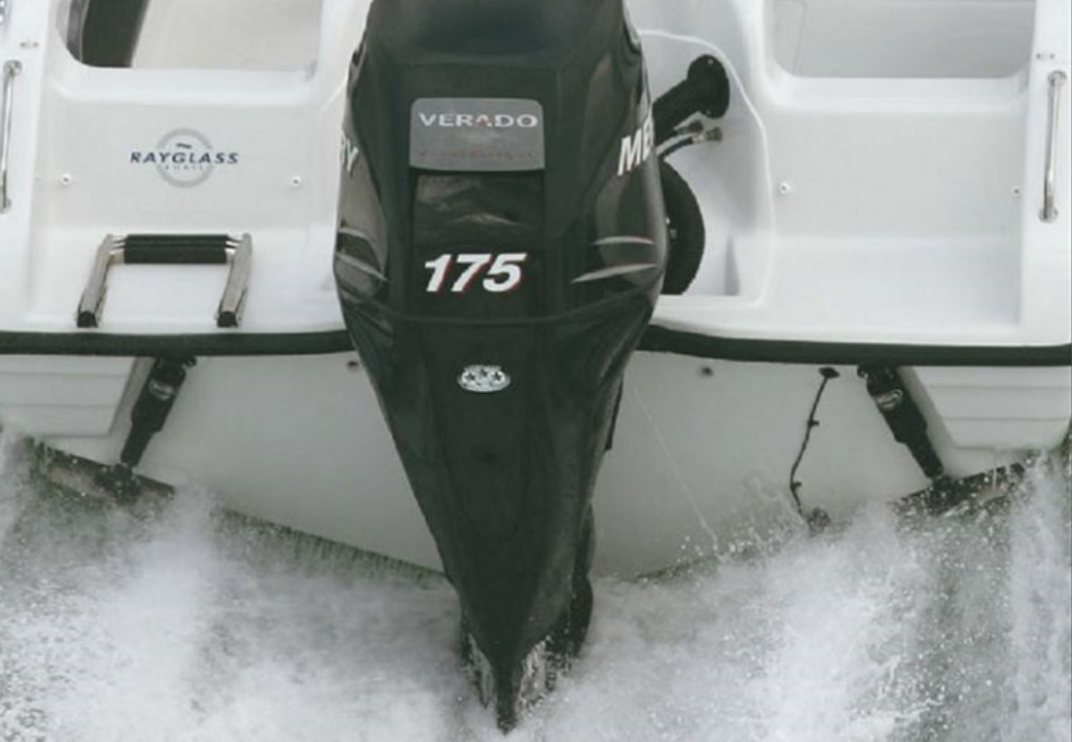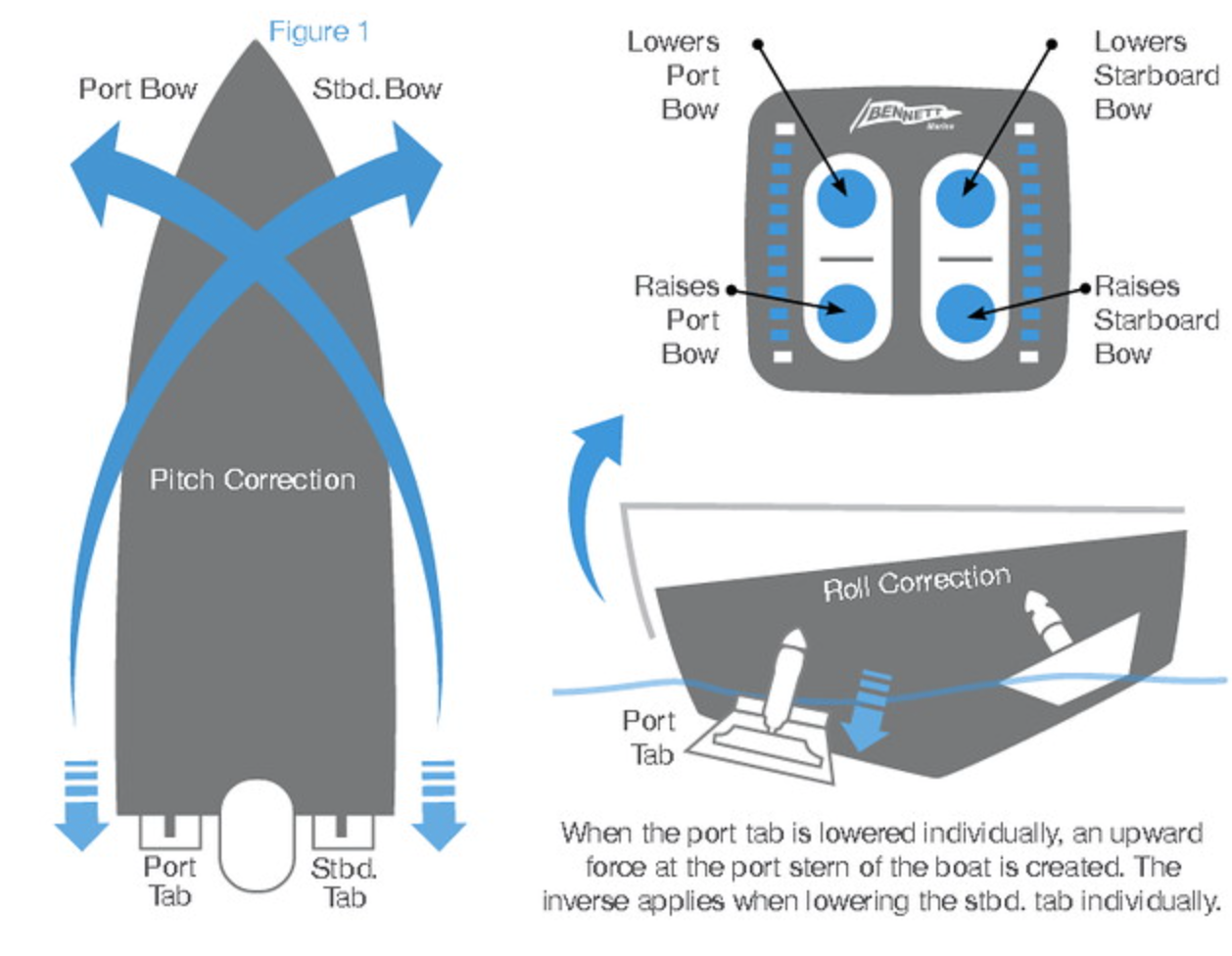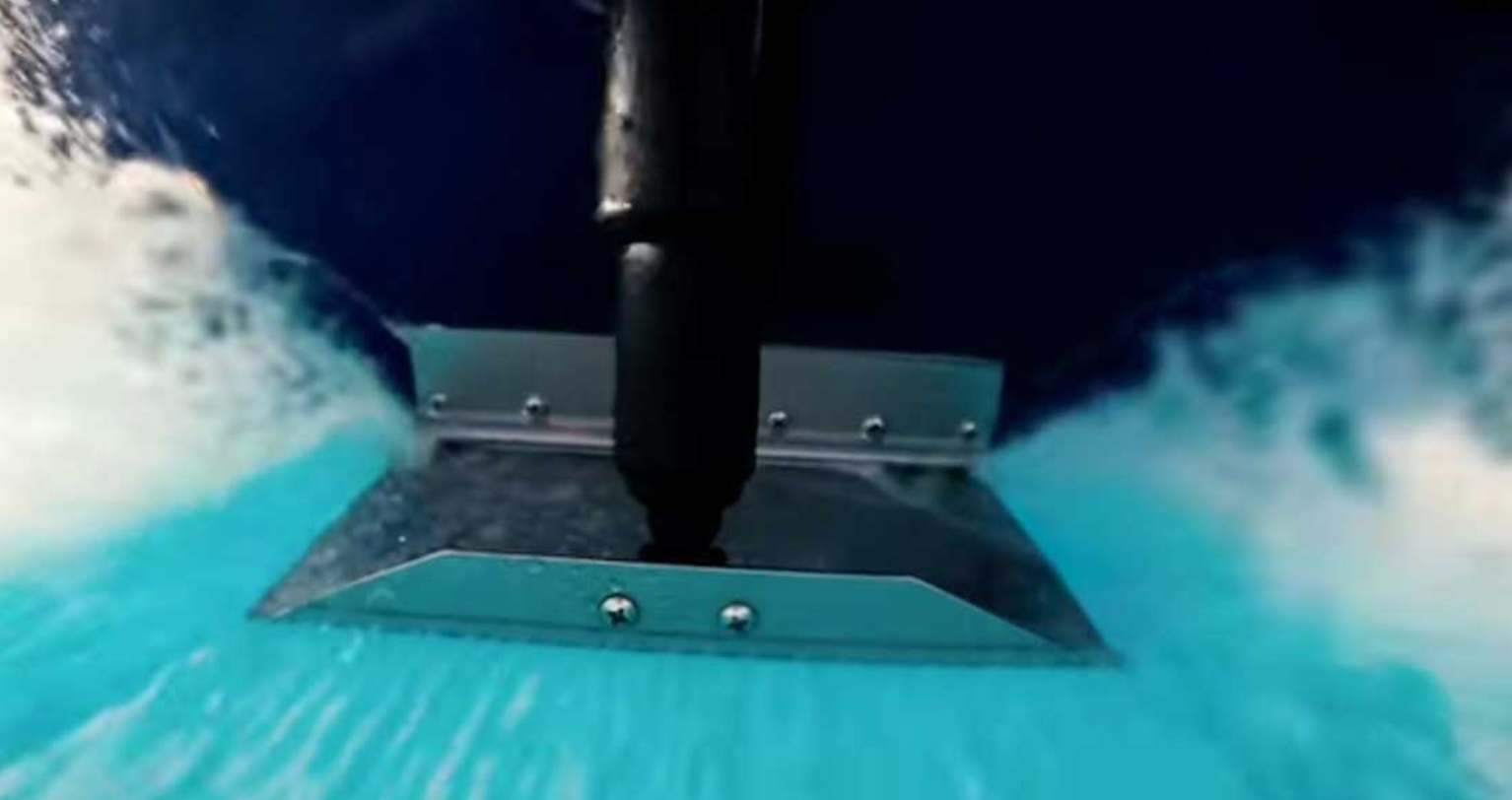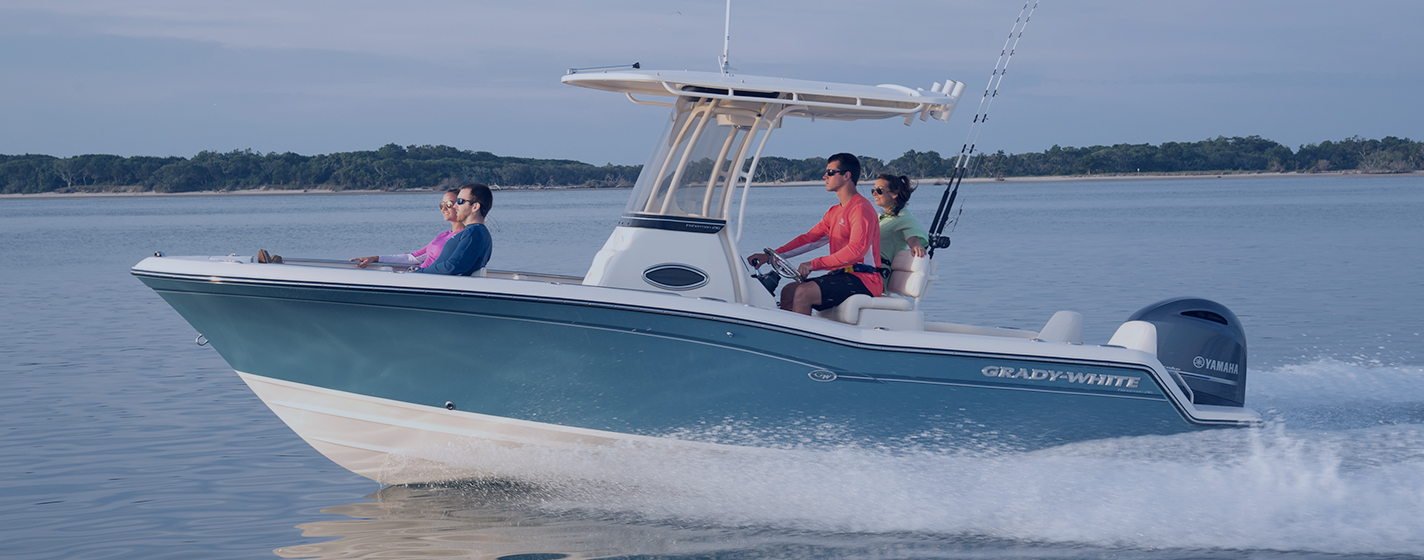Why You Need Trim Tabs: They Have Many Benefits

There are many situations where trim tabs can help a boat. For example as she slows from maximum speed, she begins to settle at the stern or “squat,” creating an inefficient, untrimmed condition. How about when the throttle is advanced and the boat moves forward, creating a period of transition from off plane to planing? A hill of water is created and in this bow-high position, visibility is limited and the hull is experiencing increased drag. These are just two instances where trim tabs can help.
Uneven weight distribution is the cause of a boat listing to one side. Wind can cause the same thing, especially on a boat with an enclosed pilothouse or flying bridge. Tabs can fix all those issues. They range from simple fixed manual units to the new breed of sophisticated electronic self-levelling controls. Modern tabs can sync with a boat’s drive system to take the guess work out of trim and set the boat at the best possible riding attitude.
How Will Tabs Affect My Boat?
In the past, trim tabs were most often found on cruisers and fishing boats longer than 23’ (7 m), but today they have become common equipment on boats as short as 16’ ( 5 m). Trim tabs are on everything from open boats with tiller steering to bow riders, cruisers and hardtops. Many believe that trim tabs are less important on smaller boats, but, in fact, the opposite is true. Trim tabs improve the ride for even the largest planing hulls, but on a smaller boat, we may notice the difference more. For instance, bigger boats are much less affected by weight distribution than smaller boats.

A quick touch of a tab button will bring a small boat back onto the right longitudinal or lateral trim angle to create a better ride. When trimmed correctly, a boat will offer a softer, more comfortable ride. After decades of time the water, we’ve seen that all boats, large and small, benefit from trim tabs for the same reasons — they improve planing and, although probably only marginally, fuel efficiency. They also correct for uneven weight distribution, and they improve the speed, safety and overall performance.
On a performance boat set up for speed, trim tabs help it up on plane quickly without digging the stern down deep in the water and launching the bow skyward. Put the tabs down and the boat will pop up on plane. As speed increases, alter the tabs’ angle for the sea conditions.
Enhanced Utility
Standard tabs on the family runabout let the boat pull heavier or multiple skiers and slow down for the smaller kids without going bow high. Tabs also enhance safety. Use them to improve visibility and avoid running over something you did not see. When towing a wakeboarder or surfer on a boat without ballast, run with the tabs hard down and the engine trimmed in. This can create a larger wake.
Most larger cruisers come standard with tabs and many have automated trim systems. On larger, heavier cruisers, tabs help with planing and handling in big seas.

Buying Trim Tabs?
Before purchasing trim tabs, make sure there is room to install them. Check the transom design and measure for clearance around swim platforms or ladders. About 12” (30 cm) along the bottom of the boat and a foot (30 cm) vertically from the point in the center of the tab is required. Anyone handy with a drill and screwdriver can install trim tabs. Depending upon the size and construction of the boat, it should take a few hours.
Determining Trim Tab Size
Installing undersized trim tabs is a common mistakes. A tab that is too small will have to be deflected more in order to create sufficient lift. Just remember, the larger the trim tab, the more lift it will produce with the least amount of drag. Most manufacturers supply a sizing guide to make your choice a lot easier.
Many factors affect the choice of properly sized trim tabs. Our recommendations are based on an average performance. Factors affecting choice may vary based on power, engine configuration, weight distribution, type of boat and use. The greater the surface area, angle of deflection and/or speed of the water flowing under the trim tab, the greater the lift. When making a choice between trim tab sizes, remember that the largest trim tabs that will comfortably fit on the transom will be the most efficient.

Whenever possible, choose a 8.7” (22 cm) chord (fore and aft measurement) trim tab, and gain lift through a longer span (side to side measurement). The span of the trim tab has more of an effect on the amount of lift. However, a longer chord can be used effectively and there are situations where you may need to use a 12” (30 cm) chord.
This is especially applicable when there is limited transom space with a twin-engine set up. Also, slower boats ( less than 15 mph/25 kmph), semi-displacement hulls, boats longer than 49’ (15 m), outboard brackets or boats with any other feature that increases the need for lift aft benefit from the 12” (30 cm) chord. The longer chord provides greater surface area, covers more water flow and provides more lift.
How to Use Trim Tabs
The key to getting the best results from trim tabs is to operate them in short bursts and let the boat react before making another adjustment. The amount of time between corrections is influenced by the size of the trim tabs and the boat’s speed.
Operating the tabs this way will help avoid over-trimming, which occurs when you’ve deflected the tabs too far. An over-trimmed boat will plow or bow-steer. When this happens, simply raise the tabs and the bow will rise. Bennett Marine’s hydraulically-adjustable trim tabs can be pre-set at the factory so the boat never runs in an over-trimmed condition.

When steering from a bridge or tower, a good trimming method is to watch the bow spray, stern wake, or the rooster tail. An untrimmed boat will produce more spray aft of the bow and it creates a larger wake. When trimmed, the spray is farther forward, the wake is reduced and the rooster tail is smaller and farther behind the boat. Engine rpm will also increase when the boat is properly trimmed.
When weight is properly distributed or there is prop torque or wind, a boat can run with a list. Deep V and taller boats are particularly vulnerable to this condition. It’s easy to level the boat with tabs. Tabs set up for pleasure use are designed to deploy in concert with the position indicated on the control buttons. Pressing the port side “Bow Down” button lowers the trim tab on the starboard side. If the starboard bow is high, push the starboard button for “Bow Down” adjustment.
Properly sized trim tabs can also reduce the time needed to get on plane. They help keep the bow down and stay on plane at lower speeds. As the throttle is advanced, the stern begins to squat, lifting the bow. As the boat accelerates, push the tab bow down buttons with small taps. The boat reacts by lifting the stern, reducing bow rise and increasing speed while the engine labors less.

Using Drive/Engine Trim and Tabs Together
It is a common misconception that if a boat has a power trim on the outboard or sterndrive, it does not need tabs. Power trim can be used to adjust the boat’s attitude, but it’s inefficient. This is because a propeller is designed to force the boat forward. When trimming the boat with the drive or outboard, the prop must push the boat forward and raise the stern. Prop slippage is greatly increased, which wastes rpm. In single-engine applications, power trim cannot correct listing.
For increased speed and power, use trim tabs with your power trim. Tabs trim the hull, while the drive trim adjusts the prop. The result is optimum performance and efficiency. To achieve this do the following:
- Adjust the trim tabs to achieve a planing attitude.
- Use the power trim to position the prop path parallel to the water flow.
- If necessary, re-adjust the trim tabs to “fine-tune” the ride. A frequently used technique is to trim the tabs to level and then use as much positive drive trim for maximum speed and efficiency. Many performance-boat operators mark their indicators to note where the tabs are level with the bottom.
Using Tabs For Sea Conditions
For the most comfortable ride when running into a head sea, use the tabs to trim the bow down. This lets the sharper forward entry cleave the waves so the boat doesn’t pound on the flatter sections of the bottom.
In a following sea, raise the tabs. Do the same when running in an inlet so the tide or current won’t push the stern from side to side. Having the tabs up lifts the stern, keeps reduces bow rise and keeps the engine from laboring less.
Boats operating in beam seas often throw spray on the windward side. This spray can be carried aboard by the wind. Tabs can be used to raise the windward side of the boat, blocking the spray.
Using Tabs to Correct Porpoising
Porpoising is a condition more common in performance boats. As speed increases, the bow repeatedly rises out of the water until gravity overcomes lift and the bow bounces down. Lower the tabs with quick taps until the porpoising subsides. It shouldn’t take much negative trim and speed should remain the same or increase.

Tab Position When Backing Up
When operating the boat in reverse, both trim tabs should be fully raised. Tabs produce drag if they are left down when backing up. This puts a strain on the tabs and affects the boat’s handling in reverse. Additionally, if one tab is deflected more than the other in reverse, the boat tends to pivot around the deflected tab.